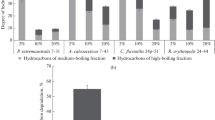Abstract
The ways of the creation of cyanobacterial-bacterial communities with a high remediation potential for cleaning of oil-contaminated soils and water reservoirs are considered. A special methodology was elaborated for the obtaining of bacteriologically pure (axenic) cultures of cyanobacteria: Phormidium sp. K-1, Oscillatoria sp. A-2, and Oscillatoria sp. C-3. It was shown that 14 strains of bacteria associated with these cyanobacteria manifest a hydrocarbon-oxidizing activity. They belong to the genera Pseudomonas, Alcaligenes, Arthrobacter, and Bacillus. The usage of oil-degrading bacteria, which we isolated from water reservoirs or took from collections, allowed us to construct artificial cyanobacterial-bacterial communities with a high hydrocarbon-oxidizing activity. In field experiments on the landfill site Khimpromservis Aktobe, the high remediatory effect of cyanobacterial-bacterial associations between Phormidium sp. K-1 sp. and bacteria Pseudomonas stutzeri A1, Pseudomonas sp. N2, and P. alcaligenes A5 was demonstrated. The results obtained are the basis for the elaboration of microbiological technologies of environment protection using cyanobacteria.
Similar content being viewed by others
References
Kurakov, A.V., Il’inskii, V.V., Kotelevtsev, S.V., and Sadchikov, A.P., Bioindikatsiya i reabilitatsiya ekosistem pri neftyanykh zagryazneniyakh (Bioindication and Rehabilitation of Ecosystems at Oil Pollution), Moscow: Grafikon, 2006.
Raiskaya, G.Yu., Features of the process of self-purification of oil pollution in specific artificial reservoirs, Cand. Sci. (Biol.), Dissertation, Moscow: Mosk. Gos. Univ., 2003.
Krings, M., Hass, H., Kerp, H., Taylor, T.N., Agerer, R., and Dotzler, N., Endophytic cyanobacteria in a 400-million-year-old land plant: a scenario for the origin of a symbiosis? Rev. Palaeobot. Palynol., 2009, vol. 153, pp. 62–69.
GOST 17.1.3.07-82. Okhrana prirody. Gidrosfera. Pravila kontrolya kachestva vody vodoemov i vodotokov (State Standard 17.1.3.07-82. Protection of Nature. Hydrosphere. Rules for the Control of Water Quality in Ponds and Streams), Moscow, 1982.
GOST 17.1.5.05-85. Okhrana prirody. Gidrosfera. Obshchie trebovaniya k otboru prob poverkhnostnykh i morskikh vod, l’da i atmosfernykh osadkov (State Standard 17.1.5.05-85. Protection of Nature. Hydrosphere. Common Requirements for Sampling the Surface and Marine Waters, Ice, and Atmospheric Precipitations), Moscow, 1985.
Pinevich, G.D., Verzilin, N.N., and Mikhailov, A.A., Study of Spirulina platensis — new object of high culture, Sov. Plant Physiol., 1970, vol. 17, pp. 1037–1046.
Gromov, B.V. and Titova, N.N., Collection of microalgal cultures from the Laboratory of Microbiology, Leningrad University, Mezhvuzovskii sbornik “Kul’tivirovanie kollektsionnykh shtammov vodoroslei” (Interuniversity Collection of Articles Cultivation of Collection Algal Strains), Leningrad, 1983, pp. 3–27.
Dubinin, A.V., Gerasimenko, L.M., and Zavarzin, G.A., Ecophysiology and diversity of cyanobacteria in the lake Magadi, Mikrobiologiya, 1995, vol. 64, pp. 845–849.
Baryshnikova, L.M., Grishchenkov, V.G., Arinbasarov, M.U., Shkidchenko, A.N., and Voronin, A.M., Biodegradation of oil products by individual degrading strains and their associations in liquid media, Prikl. Biokhim. Mikrobiol., 2001, vol. 37, pp. 463–468.
Sirenko, L.A., Sakevich, A.I., Osipov, L.F., Lukina, L.F., Kuz’menko, M.I., Kozitskaya, V.N., Velichko, I.M., Myslovich, V.O., Gavrilenko, M.Ya., Arendarchuk, V.V., and Kirpenko, Yu.A., Metody fiziologo-biokhimicheskogo issledovaniya vodoroslei v gidrobiologicheskoi praktike (Methods for Physiological and Biochemical Studies of Algae in Hydrobiological Practice), Kiev: Naukova Dumka, 1975.
Perminova, G.N., Influence of cyanobacteria on the growth of microorganisms in soil, Mikrobiologiya, 1964, vol. 33, pp. 427–476.
Borisova, E.V., Species composition of bacteria associated with microalgae in culture, Algologiya, 1996, vol. 6, pp. 303–313.
Parker, B.C. and Bold, H.C., Biotic relationship between soil algae and other microorganisms, Am. J. Bot., 1998, vol. 48, pp. 185–197.
Goryunova, S.V., The possibility of using nitrogen-fixing cyanobacteria to improve yields of rice fields, Usp. Mikrobiol., 1971, vol. 7, pp. 195–207.
Shtina, E.A., Soil algae as the components of ecosystems, Pochvennye organizmy kak komponent biogeotsenoza (Soil Organisms as the Component of Biogeocenosis), Shtin, E.A., Ed., Moscow: Nauka, 1984, pp. 53–58.
Sainov, D.I., Features of the formation of cyanobacterial communities in anthropogenic ecosystems (Spirulina platensis as an example), Cand. Sci. (Biol.) Dissertation, Moscow: Mosk. Gos. Univ., 2000.
Yankevich, M.I., The formation of remediation biocenoses to reduce human influence on water and soil microecosystems, Sc.D. (Biol.) Dissertation, Shchelkovo: Vseros. Nauch. Issled. Techn. Inst. Biol. Promyshlennosti Ros. Akad. S.-kh. Nauk, 2002.
White, A.W. and Shilo, M., Heterotrophic growth of the filamentous blue-green algae Plectonema boryanum, Arch. Microbiol., 1975, vol. 102, pp. 1222–1227.
Kazitsyna, L.A. and Kupletskaya, N.L., Primenenie UF-, IK-, YaMRi mass-spektroskopii v organicheskoi khimii (Application of UV, IR, NMR, and Mass Spectroscopy in Organic Chemistry), Moscow: Mosk. Gos. Univ., 1979.
Fomchenkov, V.M., Kholodenko, V.P., and Irkhina, I.A., Biotestirovanie integral’noi toksichnosti zagryaznennykh pochv i vod (Bioassay of Integrated Toxicity of Contaminated Soil and Water), Moscow: Nauch. Issled. Inst. Ekonomiki Meditsinskoi Promyshlennosti, 1996.
Author information
Authors and Affiliations
Corresponding author
Additional information
Original Russian Text © A.A. Zhubanova, A.K. Ernazarova, G.K. Kaiyrmanova, B.K. Zayadan, I.S. Savitskaya, G.Zh. Abdieva, A.S. Kistaubaeva, N.Sh. Akimbekov, 2013, published in Fiziologiya Rastenii, 2013, Vol. 60, No. 4, pp. 588–595.
Rights and permissions
About this article
Cite this article
Zhubanova, A.A., Ernazarova, A.K., Kaiyrmanova, G.K. et al. Construction of cyanobacterial-bacterial consortium on the basis of axenic cyanobacterial cultures and heterotrophic bacteria cultures for bioremediation of oil-contaminated soils and water ponds. Russ J Plant Physiol 60, 555–562 (2013). https://doi.org/10.1134/S1021443713040183
Received:
Published:
Issue Date:
DOI: https://doi.org/10.1134/S1021443713040183



